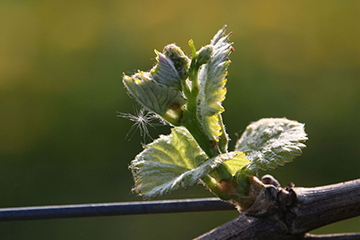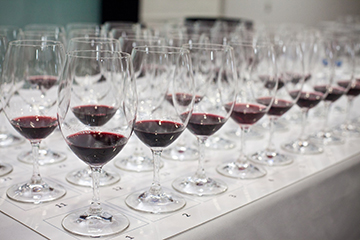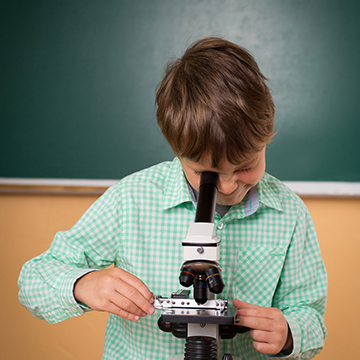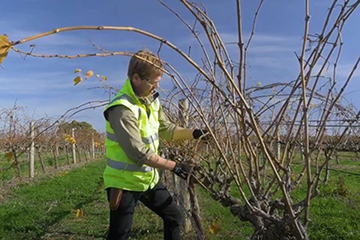13 October 2021
Powdery mildew, caused by the fungal pathogen Erysiphe necator, is one of the most economically important diseases of grapevines worldwide. It infects all green tissues of a grapevine, affecting vine health and vigour as well as berry quality. Growers rely on fungicides for disease control and sulfur is the most widely used chemical for this purpose. Sulfur offers very effective protection when good spray coverage is achieved. There are, however, several factors that can reduce the efficacy of sulfur, including incorrect spray timing, poor coverage and adverse weather conditions.
This eBulletin addresses concerns raised by some growers about the efficacy of sulfur under cooler conditions, as the vapour activity of sulfur is reduced in lower temperatures (15°C and below).
KEY POINTS
Good spray coverage is vital for good control. Sulfur kills the spores of powdery mildew on contact; therefore, good coverage of plant tissue ensures a high level of contact and contro It is well established that good coverage is the key to controlling powdery mildew with sulfur.
25°C to 30°C is the optimum temperature. Sulfur’s efficacy is improved at temperatures above 18°C as it becomes volatile and begins to ‘fumigate’ the foliage and bunches, reaching areas not contacted by the spray.
Phytotoxicity can occur above 32°C. Phytotoxicity has been identified as a risk at temperatures over 32°C when the humidity is above 70%. High humidity slows the drying process of the acidic sulfur solution and can result in damage to fruit and foliage.
Sulfur is still effective under cool conditions. At temperatures below 15°C the vapour activity of sulfur is limited; however, good control can still be achieved with good spray coverage. A study on the effect of temperature on the efficacy of sulfur at controlling powdery mildew on grapevine in Australia by Emmett et al. (2003) involved laboratory and field experiments and found the following:
- No significant differences in sulfur efficacy between 15°C and 20°C at sulfur rates of 200 g/100L in all laboratory experiments except one on detached leaves.
- No significant differences between 15°C and 20°C at sulfur rates of 300 g/100 L in all laboratory experiments on seedlings.
- No significant differences between sulfur rates of 300 and 600 g/100 L if the coverage was good in all laboratory experiments. However, there was a large difference between these two rates when the coverage was poor.
- No significant differences between sulfur rates of 300 and 600 g/100 L in field experiments conducted in cool or warm conditions, especially with regards to the severity of the disease.
Higher rates of sulfur can affect beneficials. Sulfur product labels recommend higher rates when there is high disease pressure or in cooler climates; however, this practice should be considered in the context of the impact of sulfur on beneficial biological agents. Conventionally managed vineyards can choose from a long list of registered agrochemical options to protect against powdery mildew, as detailed in the AWRI ‘Dog book’. Organically managed vineyards have fewer options but can use potassium bicarbonate as an alternative to sulfur.
TAKE HOME MESSAGES
✓ Uniform coverage is critical when using sulfur in cool conditions.
✓ The low label rate is adequate with good spray coverage.
✓ There are alternatives to sulfur under cool conditions.
ACKNOWLEDGEMENTS
The AWRI acknowledges Drs Ismail Ismail, Suzanne McKay and Mark Sosnowski from the South Australian Research and Development Institute (SARDI), Primary Industries and Regions and Liz Riley from Vitibit Pty Ltd for their contributions to this eBulletin.
FURTHER READING
Emmett, B., Wicks, T., Hitch, C., Rozario, S., Hawtin, J., Deland, L., Jaeger, C. 2003. Final report to the GWRDC. Strategic use of Sulphur in integrated pest and disease management (IPM) programs for grapevines.
Kunova, A., Pizzatti, C., Saracchi, M., Pasquali, M., Cortesi, P. 2021. Grapevine powdery mildew: fungicides for its management and advances in molecular detection of markers associated with resistance. Microorganisms 9(7): 1541.
Madge, D. 2005. Organic Farming: Managing grapevine powdery mildew. State of Victoria, Department of Primary Industries. Agriculture Notes.
Magarey, P. 2010. Managing Powdery Mildew: (Doing it better!). GWRDC innovators network fact sheet.
Agrochemicals registered for use in Australian viticulture
Wine Australia’s powdery mildew resources
The AWRI’s powdery mildew resources











